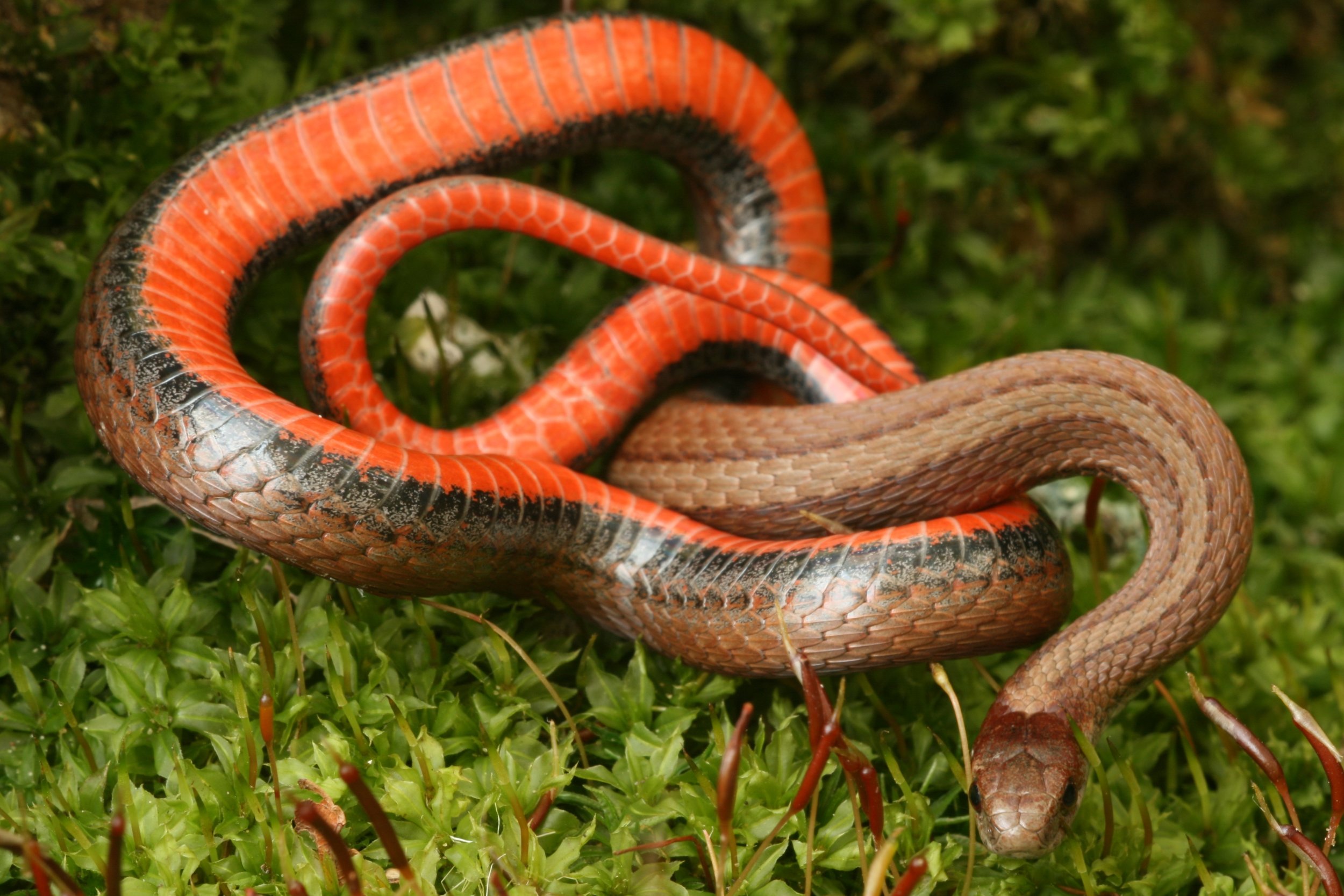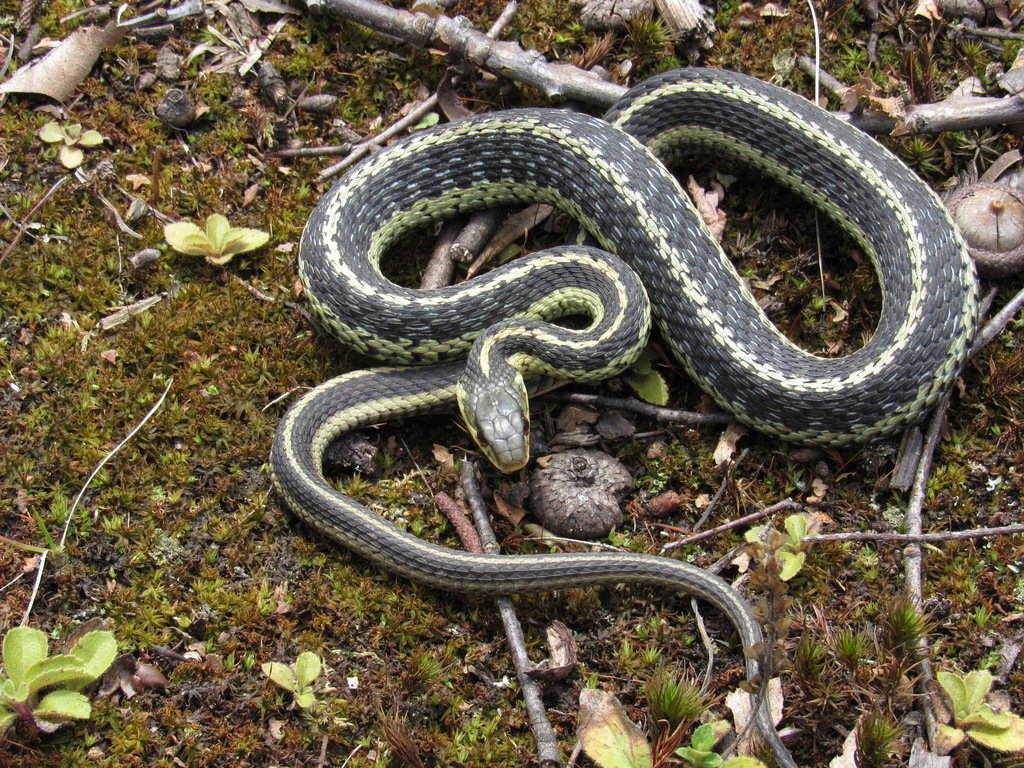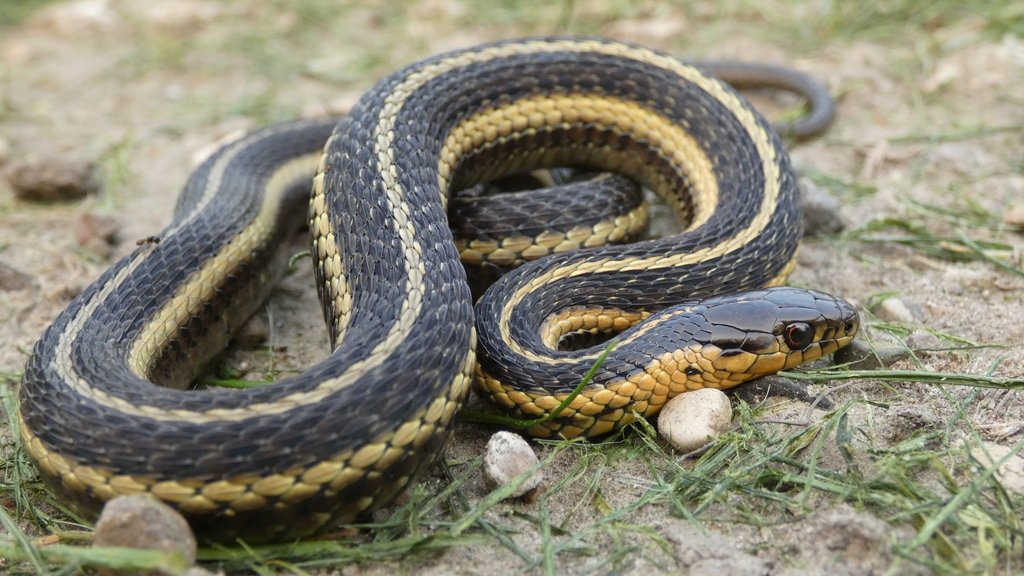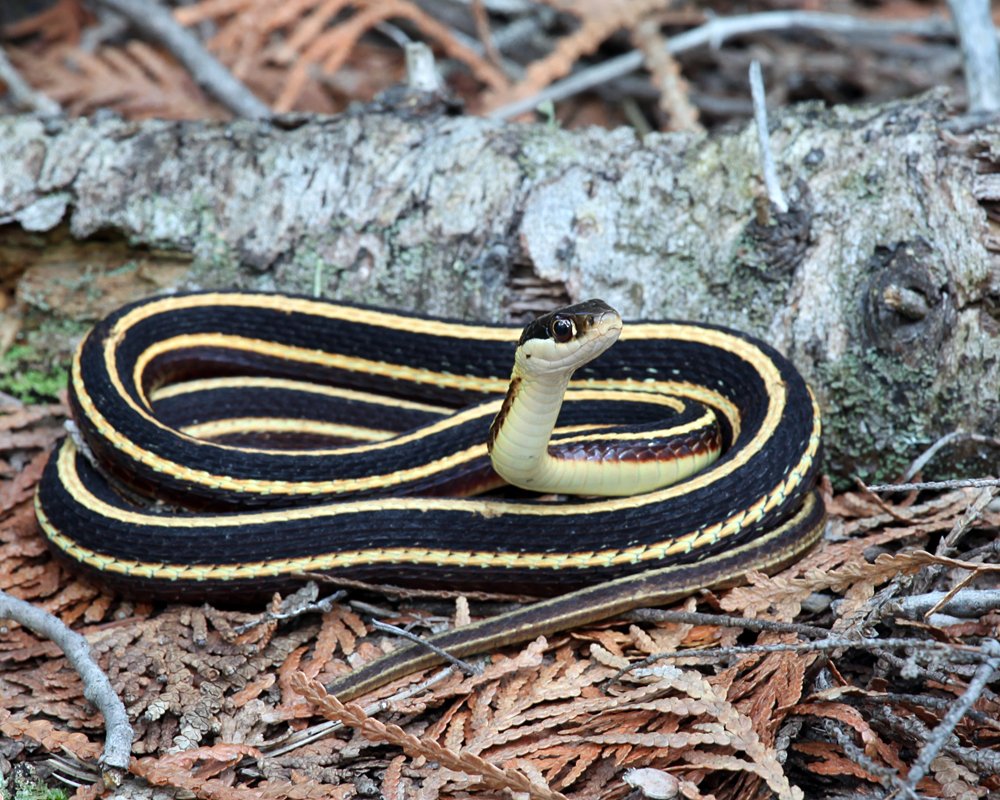
Snakes of Michigan

See a massasauga?
Let conservationists know by reporting it here!
Family Viperidae
Subfamily Crotalinae
Eastern Massasauga Rattlesnake - "Sistrurus catenatus catenatus" (1)
Photo by Phil Myers, 2008.
Habitat: usually lowland wetlands
Adult size: 18 to 40 inches (47 to 100 cm)
Color/pattern: gray to brown background with dark, irregular blotches. Belly color is usually black with light mottling.
Defining features: the only truly venomous snake in Michigan; thick-bodied with a rattle at the tip of the tail, cat-like slit pupils, keeled scales, and heat pits
Diet: mainly small mammals, but sometimes other snakes, frogs, birds, bird eggs, and insects, especially when younger.
Behavior: these snakes will rattle their tail when threatened. They prefer grassy areas to bask and hunt.
Fun Facts: 'massasauga' means 'great river mouth' in the Chippewa language
- Young eastern massasauga rattlesnakes entice frogs and toads to come closer by twitching their tail tips.
- Although venomous, bites are uncommon and rarely dangerous. Regardless, avoid handling these snakes and seek medical attention immediately if bitten.
How can you help?
You already are! Learn about snakes by going to zoos and your local nature centers!
Familiarize yourself with your local wildlife so you know what’s safe and what isn’t.
Teach others about the importance of snakes in your local ecosystems.
Protect the wetlands that massasaugas and other species depend on to survive.
Respect snakes’ space and observe them from a distance.
Report any massasauga sightings to the DNR! This information will help inform conservation efforts.
Questions:
How could you identify this snake if you saw it in the wild? (Easy)
What does venomous mean? (Easy) How is this different from poisonous? (Hard)
Why do you think snakes would need venom? What do they use it for? (Easy)
Why do these snakes have heat-sensing pits? (Easy)
Why are wetland habitats important? (Hard)
What do I do if I see or hear a massasauga?
Stay calm and be still. If you can’t see the snake, try to determine the snake’s location. Slowly move away from the snake and allow it to move away from you.
If the snake is in your yard or another unsafe place, contact your local animal control for guidance.
This species is federally threatened; therefore, it is illegal to harm or kill these snakes. Most snake bites occur when someone tries to kill or harm the snake, so when in doubt, leave it alone.
You can prevent these snakes from entering your yard by keeping your grass short and well as removing leaf litter, brush piles, dead logs, or stacks of firewood.
If bitten, seek medical attention immediately.
If you’d like to help the conservation of this species, consider reporting your sighting to the DNR via the link above!
TRICK or TOXIN?
Many snakes pretend to be their venomous lookalikes to scare away potential predators. Can you tell the difference?
Eastern hognose snakes, pictured above, are a common mimic of the eastern massasauga rattlesnake, pictured below (photo by James Chiucchi).
When threatened, several native Michigan snakes will try their best to pretend to be a venomous massasauga to trick a potential predator into leaving it alone. This act can include hissing or tail-wagging against dry leaves to mimic a rattle, puffing up to look larger, and even adopting a similar body shape, head shape, color, and pattern as a massasauga.
However, massasaugas are the only species of viper native to Michigan, having slit pupils, heat pits, and a distinct triangular head. Potential pretenders include eastern hognose snakes, northern water snakes, black rat snakes, and fox snakes.
Batesian Mimicry in Action
Some noxious organisms, whether poisonous or venomous, will adapt ways to warn potential predators against trying to eat them. These warning signs are called aposematism. In venomous snakes, these signs can include the rattle of rattlesnake or the bright colors and pattern of coral snakes. .
Batesian mimicry is a phenomenon where a harmless organism will mimic the warning system of a dangerous organism. The traits mimicked can include coloration, pattern, sounds, and behaviors.
QUESTIONS
How can you tell the difference between a massasauga and potential fakers?
Why is it important to be able to tell the difference between native species of snakes?
Subfamily Xenodontinae
-

Northern Ring-necked Snake - "Diadophis punctatus edwardsii" (2)
Photo by Patrick Randall, 2011.
Habitat: found in diverse habitats, but prefer coverage such as stones and loose bark
Adult size: 10 to 18 inches (25 to 46 cm)
Color/pattern: solid blue, brown, or gray with a gold to orange ring around the neck. The belly is solid and the same gold-orange.
Defining features: smooth scales; when alarmed, the tail will coil and raise toward the threat to display their bright color and will sometimes play dead
Diet: small salamanders, lizards, and frogs, as well as earthworms and juvenile snakes of other species
Fun facts: these snakes are social animals, sometimes living in large groups of 100 snakes or more
Questions:
What colorful animals have you seen while outside?
What do bright colors in nature usually mean? (Easy) What is this defense mechanism called? (Hard)
Why would a snake flip over to show their bright colors? (Easy)
-

Eastern Hognose Snake - "Heterodon platirhinos" (3)
Photo by David Schliepp.
Habitat: usually areas with dry, sandy, or mixed sandy soils
Adult size: 18 to 41 in (45 to 105 cm)
Color/pattern: as adults, these snakes vary greatly in color from light brown, light gray, red, tan, grayish green, yellowish, and even solid dark gray or black. Snakes with lighter colorations usually have an alternating pattern of dark blotches. The belly varies in color from white to a light gray.
Defining features: keeled scales; thick bodied with wide heads and an upturned snout. These snakes often flatten their heads and ribs similar to a cobra when threatened. They will also sometimes play dead when provoked.
Diet: primarily toads, but will also occasionally eat small mammals, frogs, small birds, salamanders, etc.
Fun facts: these snakes are considered mildly venomous, having two rear fangs and specialized saliva. However, their bites are generally no worse than a bee sting.
Questions:
Why would this snake make a bad pet? (Hard)
Why does this snake have an up-turned snout? What do you think it’s used for? (Hard)
Subfamily Natricinae
Fun fact: almost all snakes in this family give birth to live young instead of laying eggs!
-

Kirtland's Snake - "Clonophis kirtlandii" (4)
Photo by Todd Pierson, 2015.
Habitat: open damp areas like marsh edges and wet fields
Adult size: around 24 inches (60cm)
Color/pattern: grayish with three rows of dark blotches. The belly that is reddish with a row of black spots on each side. The head is dark with a white chin and throat.
Defining features: keeled scales
Diet: mainly earthworms and slugs
Conservation status: endangered in Michigan
Fun facts: this species likes to make its home around big cities, so it’s threatened by human development and pollution
Questions:
What does endangered mean? (Hard)
Give me two reasons that this snake may be endangered. (Easy)
-

Copper-bellied Water Snake - "Nerodia erythrogaster neglecta" (5)
Photo by Peter Paplanus, 2015.
Habitat: freshwater aquatic habitats including ephemeral ponds or temporary pools, permanent lakes and ponds, swamps, bogs, marshes, small rivers, etc.
Adult size: 30 to 64 in (76 to 163 cm)
Color/pattern: dark brown or black with a orange to red belly
Defining features: keeled scales; orange belly
Diet: mostly frogs and toads
Conservation status: endangered in Michigan
Fun facts: this species will often hibernate in crayfish burrows
Questions:
What are keeled scales? (Easy)
Name three aquatic environments where you might find this snake. (Easy)
-

Northern Water Snake - "Nerodia sipedon sipedon" (6)
Photo by Don Becker.
Habitat: freshwater aquatic habitats including rivers, streams, sloughs, lakes, ponds, bogs, marshes, etc.
Adult size: 24 to 55 inches (61 to 140 cm)
Color/pattern: dark with a brownish, tan or grayish background. The back and sides have a series of square, reddish blotches alternating with each other that may merge to form bands. Adult snakes can appear solid brown or black, especially when dry. The belly is usually white, yellowish, or orangish with dark half-moon-shaped black edges.
Defining features: keeled scales
Diet: amphibians, fish (alive or dead), crayfish, large insects, leeches, other snakes, turtles, birds, and small mammals such as white-footed mice
Conservation status: least concern
Fun facts: these snakes have been seen herding schools of fish or tadpoles to the edge of bodies of water where they can prey upon many at one time. They are also commonly mistaken as venomous species and killed by fishermen.
Questions:
What should you do if you see a snake and you aren’t sure if it’s venomous/dangerous or not? (Hard)
-

Queen Snake - "Regina septemvittata" (7)
Photo by Jason Patrick Ross.
Habitat: freshwater habitats including shallow, rocky rivers and streams, the edges of lakes, ponds, ditches, and canals, and in marshes
Adult size: 13 to 36 inches (34 to 92 cm)
Color/pattern: brownish to olive with a yellow band running horizontally down their sides and face. The belly is bright yellow with four long, dark stripes.
Defining features: keeled scales; yellow stripe along their sides
Diet: they are especially found in habitats with lots of crayfish for them to eat, but will occasionally hunt fish and tadpoles
Conservation status: least concern
Fun facts: fisherman often kill these snakes fearing that they’ll eat all the fish. Why is this not a concern?
Questions:
How would you tell this snake apart from a copper-bellied water snake? (Hard)
-

Dekay’s Brown Snake - "Storeria dekayi" (8)
Photo by Photo by Ian Deery.
Habitat: these snakes spend most of their time underground, hiding among loose stones or flat rocks that are found in the wild and in large cities.
Adult size: 9 to 21 inches (23 to 53 cm)
Color/pattern: grayish brown color with a lighter streak on its back that is bordered on each side with black dots. The belly is a pinkish white color.
Defining features: keeled scales, pale belly and ring around their neck
Diet: earthworms, snails, and slugs, but will also eat small salamanders, soft-bodied grubs, and beetles
Conservation status:
Fun facts: these snakes have specialized teeth for scooping snails out of their shells
Questions:
How could you tell this snake apart from a ring-neck snake? (Hard)
-

Northern Red-bellied Snake - "Storeria occipitomaculata occipitomaculata" (9)
Photo by Kevin Collison.
Habitat: these snakes like damp, moist environments such as areas near rivers, creeks, and bogs.
Adult size: 8 to 16 inches (20 to 40 cm)
Color/pattern: brown to reddish brown with a varying number of light or dark stripes. sometimes with one light stripe to four faint, dark dorsal stripes or one. The belly is usually a striking bright red, but is known to occur in orange, faint yellow, pink, and infrequently in gray or black. The head is usually brown or reddish brown on top with a white throat and chin underneath. There are three light spots around the neck (one on top and one on each side) that can mix together to form a collar.
Defining features: keeled scales, red belly, light spots at the base of the head
Diet: specialized feeders of gastropods, sometimes only eating slugs. They will also sometimes eat earthworms, snails, and small isopods.
Conservation status: least concern
Fun facts: these snakes will sometimes curl their lip to show off their front teeth. They will also flip over and play dead if threatened, also showing off its red belly.
Questions:
How could this snake help out in the garden? (Easy)
How could you tell this snake apart from a Kirtland’s snake? (Hard)
How could you tell this snake apart from a ring-necked snake? (Hard)
-

Eastern Garter Snake - "Thamnophis sirtalis sirtalis"
Photo by Alex Kulungian, 2018.
Habitat: they seem to prefer moist, grassy environments but can be found in a wide range of environments.
Adult size: 18 to 53 inches (46 to 137 cm)
Color/pattern: this species is highly variable in pattern, usually having light stripes on a dark background. However, the color is variable and the stripes may be interrupted or absent.
Defining features: keeled scales; thick-bodied with a head wider than their neck
Diet: these snakes eat a wide variety of prey including earthworms, amphibians, leeches, slugs, snails, insects, crayfish, small fish, other snakes, small mammals and birds, etc.
Conservation status: least concern
Fun facts: they are immune to the toxins secreted by the skin of toads. They are also very similar in appearance to their close relatives, ribbon snakes and Butler's garter snakes.
Questions:
How could being able to eat lots of different kinds of foods be useful? (Hard)
-

Butler's Garter Snake - "Thamnophis butleri" (11)
Photo by Antoni W., 2020.
Habitat: prefer wet meadows and prairies, but are often found near marshy ponds and lake borders
Adult size: 15 to 29 inches (38 to 74 cm)
Color/pattern: three yellow or orange stripes that run along the length of their body on a background color of black, brown, or olive. They sometimes have two rows of dark spots running between their central stripe and the two side stripes. Their belly color is pale green or yellow with black spots running along the edges.
Defining features: this species is broad-bodied with keeled scales and
Diet: mostly earthworms with occasional leeches, small frogs, and salamanders
Conservation status: least concern
Fun fact: this species can be distinguished from their close relatives by the position of their lateral stripes (see the link for more details).
-

Northern Ribbon Snake - "Thamnophis saurita septentrionalis" (12)
Photo by Philippe Blais, 2015.
Habitat: prefer wet meadows and fields, especially near the edges of lakes, ponds, streams, and marshes
Adult size: 18.11 to 33.94 inches (46.0 to 86.2 cm)
Color/pattern: They have three white, yellow, or greenish stripes that run along the length of their body on a background color of black or dark brown. Their belly is white, yellow, or green without blotches. The scales above their mouth are bright white or yellow, without dark borders (as in garter snakes).
Defining features: keeled scales; slim bodied with long tails relative to their body. The head is wide with large eyes are bordered by a light bar in front.
Diet: frogs and salamanders and their larvae as well as fish
Conservation status: least concern
Questions:
How could you tell a ribbon snake from a Eastern garter snake?
Subfamily Colubrinae
-

Blue Racer - "Coluber constrictor joxii" (13)
Photo by Peter Paplanus, 2016.
Habitat: prefer dry sunny areas with access to cover, including old fields, open woodland, etc. They can sometimes be found in damper areas such as lake edges, marshes, etc.
Adult size: 35-75 inches (90-190 cm.)
Color/pattern: this species is generally black, bluish, gray, to olive brown. The chin, throat and belly range from black, dark gray, light blue, white, cream or yellow.
Defining features: smooth scales, distinct brow ridges, narrow head
Diet: a wide range of prey ranging from insects, spiders, small frogs, small reptiles (including lizards and snakes and their eggs) and young rodents and shrews when they are young. As adults, they may eat nestling birds and their eggs, other mammals as large as squirrels and small cottontail rabbits, small turtles and larger snakes.
Conservation status: least concern
Fun fact: a racer’s top speed is about 4mph (6.5kph), or the speed of a brisk walk.
Despite their scientific name, racers do not constrict their prey
-

Black Rat Snake - "Pantherophis obsoletus" (14)
Photo by Peter Paplanus.
Habitat: wide range of habitats
Diet: primarily small rodent eaters, but occasionally eat bird eggs, small lizards and frogs.
Size: 42-72 inches (106.7-183 cm)
Conservation status: least concern
Color/pattern: mostly black with vague blotches of darker color and a white chin
Distinguishing features: this snake is mostly black with vague markings in younger animals and a white chin
Fun fact: when threatened, this species will wiggle their tails to mimic a rattlesnake
Question:
Why would a non-venomous snake want to mimic a rattlesnake? (Easy)
How could using rat poison to control a rodent problem in your house hurt these snakes? (Hard)
-

Eastern Fox Snake - "Pantherophis gloydi" (15)
Photo by Peter Paplanus, 2016.
Habitat: flat, marshy or partially drained areas in South East Michigan
Diet: small mammals, frogs, birds, and occasionally bird eggs
Adult size: 4 to 7 inches (91 to 179 mm)
Conservation status: threatened in Michigan, near-threatened elsewhere
Color/pattern: yellow to brown base color and dark blotches ranging in color from chocolate to black. Their belly is yellow and checkered with black.
Distinguishing features: slightly keeled scales
Fun fact: These snakes subdue their prey through constriction.
Questions:
What does constriction mean? (Hard)
-

Western Fox Snake - "Pantherophis vulpinus" (16)
Habitat: commonly found in grasslands, prairies, dune areas, farm fields, pastures, and woodlots in Michigan’s Upper Peninsula
Adult size: 36 to 71 inches (91 to 179 cm)
Color/pattern: blotched snake with light brown to black spots. The head varies from brown to reddish. The belly is yellow and checkered with black.
Defining features: weakly keeled scales
Diet: small mammals and occasional birds
Conservation status: least concern
Fun fact: their reddish head is often mistaken as a copperhead and often spells the end of that snake.
Questions:
How would you distinguish an Eastern from a Western fox snake? (Hard)
-

Eastern Milk Snake or Scarlet Kingsnake - Lampropeltis triangulum triangulum (17)
Photo by Peter Paplanus, 2021.
Habitat: this species thrives in a variety of habitats, often close to human activity
Adult size: 14 to 69 inches (35 to 175 cm)
Color/pattern: a very colorful snake; they have a base color of gray or tan with a collar on the neck. Black bordered "blotches", brown or rust colored down the sides of the body are common as are red, orange, yellow, or white "blotches" with colorful borders, depending on the subspecies.
Defining features: smooth scales
Diet: rodents such as voles, mice, and rats, but will also eat birds, bird eggs, lizards, snake eggs, or other snakes
Conservation status: least concern
Fun fact: This species also constricts its prey before swallowing it whole.
-

Smooth Green Snake - "Opheodrys vernalis" (18)
Photo by Peter Paplanus, 2016.
Habitat: grassy, open areas, such as meadows, bogs, and open woods, usually close to a water source
Adult size: 12 to 26 inches (30 to 66 cm)
Color/pattern: smooth, bright green body and and a white or yellow belly
Defining features: smooth scales; tail makes up around half the length of their body
Diet: mostly insects
Conservation status: least concern
Questions:
Why would being bright green be helpful to a snake? (Easy)
EASY QUESTIONS
Are there venomous snakes in Michigan? If so, name them.
List five things that snakes in Michigan eat.
Name one endangered or threatened snake that lives in Michigan.
You see a snake that flattens its head like a cobra and has an upturned snout like a pig. What species of snake is it?
Name a native snake that can have a bright orange belly.
HARD QUESTIONS
What snake am I describing? A 2ft long snake with keeled scales and three bright yellow stripes on a dark background. They have big eyes with a white bar in front of them.
How do you tell the difference between a red-bellied water snake and a queen snake?
Why would having the ability to eat toxic toads be an advantage?
Give two examples of how snakes can help with pest control at your house.
Why are common names not as useful as scientific names?
What do all the threatened or endangered snakes in Michigan have in common?


